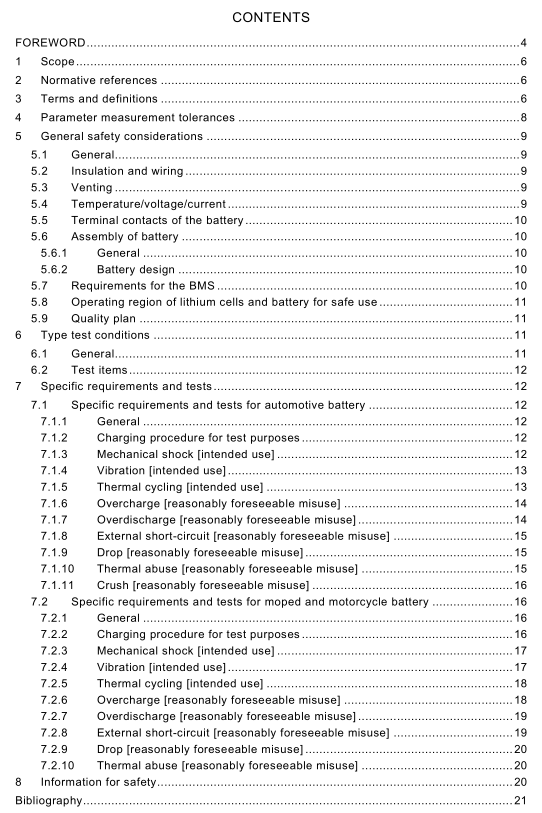IEC 63057 pdf – Secondary cells and batteries containing alkaline or other non-acid electrolytes – Safety requirements for secondary lithium batteries for use in road vehicles not for the propulsion

IEC 63057 pdf – Secondary cells and batteries containing alkaline or other non-acid electrolytes – Safety requirements for secondary lithium batteries for use in road vehicles not for the propulsion
The details of the instrumentation used shall be provided in any report of results.
5 General safety considerations
5.1General
The safety of lithium secondary batteries requires the consideration of two sets of appliedconditions:
1) intended use;
2) reasonably foreseeable misuse.
Batteries shall be so designed and constructed that they are safe under conditions of bothintended use and reasonably foreseeable misuse.
lt is expected that batteries subjected to misuse can fail to function. However, even if such asituation occurs, they shall not present any significant hazards.
Potential hazards which are the subject of this document are:a) fire,
b) explosion.
Conformity with 5.1 to 5.7 is checked by the tests of Clauses 6 and 7, and in accordance withthe appropriate standard.
5.2 lnsulation and wiring
Wiring and its insulation shall be sufficient to withstand the maximum anticipated voltage,current,and temperature requirements. The design of wiring shall be such that adequateclearances and creepage distances are maintained between conductors. The mechanicalintegrity of the battery and its connections shall be sufficient to accommodate conditions ofreasonably foreseeable misuse.
5.3Venting
The casing of the battery shall incorporate a pressure relief function that will preclude ruptureor explosion. lf encapsulation is used to support cells within an outer case,the type ofencapsulant and the method of encapsulation shall neither cause the battery to overheatduring normal operation nor inhibit pressure relief.
5.4Temperaturelvoltagelcurrent
The design of batteries shall be such that abnormal temperature-rise conditions are prevented.The battery shall be designed within voltage,current, and temperature limitations specified bythe cell manufacturer. The battery shall be provided with specifications and chargeinstructions for vehicle manufacturer or battery-charger manufacturer so that associatedchargers are designed to maintain charging within the voltage, current and temperature limitsspecified.
NOTE Where necessary,means can be provided to limit current or voltage to sale levels during charging anddischarging.
5.5Terminal contacts of the battery
Terminals shall have clear polarity marking(s) on the external surface of the battery,and thepolarity marking(s) should be located near the terminal in order to be understood easily.
The size and shape of the terminal contacts shall ensure that they can carry the maximumanticipated current. External terminal contact surfaces shall be formed from conductivematerials with good mechanical strength and corrosion resistance.Terminal contacts shall bearranged so as to minimize the risk of short-circuits (caused by metal tools, for example).
5.6Assembly of battery
5.6.1General
. The battery should have an independent control and protection method.
. The cell manufacturer shall provide recommendations about current, voltage and
temperature limits so that the battery manufacturer or designer can ensure proper designand assembly.
Protective circuit components should be added as appropriate,and consideration given tothe vehicle.
5.6.2Battery design
The voltage control function of the battery design shall ensure that the voltage of each cell orcell block shall not exceed the upper limit of the charging voltage specified by the cellmanufacturer,except in the case where the vehicle system provides an equivalent voltagecontrol function.
The following should be considered at battery level and by the battery manufacturer:
For a battery that has several series-connected cells or modules, it is recommended that thevoltages of any one of the single cells or cell blocks do not exceed the upper limit of thecharging voltage, specified by the cell manufacturer, by monitoring the voltage of every singlecell or cell block.
5.7Requirements for the BMs
The BMS evaluates the condition of cells and batteries, and it maintains cells and batterieswithin the specified cell operating region.Key factors of the cell operating region are voltage,temperature and current for charging and discharging.
The functions of the BMS can be incorporated into the battery or into the vehicle that uses thebattery.The BMS can also be divided so that it can be found partially in the battery andpartially in the vehicle that uses the battery (see Figure 1).









